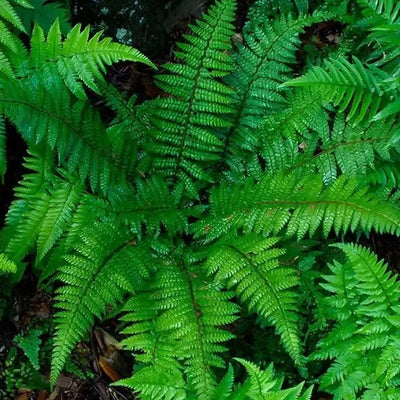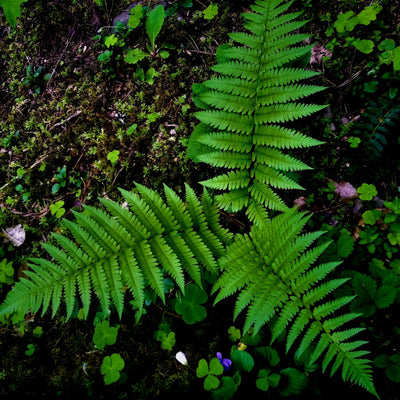Using Native Ferns As A Shade Solution
As a landowner or property manager, you know growing grass under large shade trees is hard. Give up on the grass and plant some native ferns. These plants come in a wide range of colors and textures and prefer dappled or partial shade areas.
Life Cycle of Ferns
Ferns have a life cycle that is a little different from other plants. A fern plant grows from a spore. The spore develops into a flat leafed structure called a prothallium. The prothallium develops female and male sex organs on the bottom of it. When it drops, the female egg is fertilized. The fern begins growing and becomes the plant we know as a fern plant. The fern fronds develop spores on the underside of the frond.
Size
Most ferns are one to three feet tall at maturity. Some ferns, like the resurrection fern, are only a few inches high. Others, like the royal fern and ostrich fern, can grow to be six feet tall.
Preparing The Ground
All ferns prefer well-drained soil. Prepare a bed for them by spreading three inches of compost on the bed and tilling it in the top ten inches of the soil. Some ferns prefer acidic soil while others prefer alkaline soil. You should be able to find a fern that will grow in the type of soil in your area. If you do a soil test after preparing the landscape bed, the soil test will tell you the pH. You can make any adjustments needed before planting the ferns.
Moisture Level
Most ferns prefer moist soil. They need an inch of water a week, so if it does not rain that much a week, you will have to supplement the water with irrigation. Too much water will lead to root rot. All ferns will have to be given enough water to keep the soil evenly moist the first year of their life.
Fertilization
Ferns are very sensitive to over fertilization. It is best to use a slow-release fertilizer to avoid burning the ferns. If you plant ferns native to your area and soils, you may not have to fertilize any. If you do fertilize, wait until spring growth begins to spread the fertilizer.
Erosion Control
Ferns make great erosion control in steep, shady locations where most plants struggle. They are deer and slug resistant plants. Ferns reproduce both from spores and rhizomes, so they will colonize an area and readily spread.
Choosing A Fern
We sell fourteen different ferns. Here is a bit about each of them. Choose the fern that matches the conditions you have in your garden.
Bracken Fern

Bracken ferns are the only fern that will grow in dry shade. They are distributed worldwide and are native to North America. Bracken ferns like acidic soil. Once established, they do not need supplemental watering as long as it rains every three months or so. Bracken ferns are aggressive and spread rapidly, so are great for erosion control. Their roots can reach ten feet long in their quest for ground water.
Christmas Fern
Christmas ferns got their name because they are evergreen and stay green all year. They grow 1-2 feet tall. These ferns require cool, moist, well-drained soil to grow well. The foliage will fade in too much sunlight. Christmas ferns prefer acidic soil and do not grow well in clay soils. Native to North America.
Cinnamon Fern
The cinnamon fern is native to the East coast. The fronds are green. Separate, sterile fronds emerge in the spring and quickly turn brown. Fiddleheads become yellow-green fronds which turn yellow in the fall before falling off. Cinnamon ferns like moist to wet, acidic soil. They usually are 2-4 feet tall but can occasionally grow to be six feet tall.
Fiddlehead Fern

Fiddlehead ferns are native to eastern North America and temperate Eurasia. They like swampy areas and constant moisture. Fiddlehead ferns are one of the rare ferns that will grow in the sun if the soil is kept moist. The deciduous fronds can reach 3-5 feet when mature.
Glade Fern
Glade ferns are native to the Midwest and eastern United States. Their fronds are olive green but develop a silvery sheen on the underside. These ferns grow 2-3 feet tall. Glade ferns do not tolerate being dry for very long and will turn brown in dry soil. They grow in most soils.
Hay-Scented Fern
Hay-scented ferns smell like hay when the frond is crushed. These ferns form colonies that carpet the forest floor. They grow to be 1-2 feet high and 3-4 feet wide. The dense mat of roots works to prevent erosion of the soil. Once established, these ferns need very little care. Deer do not like hay-scented ferns, so usually won’t eat them. Rabbits also dislike this fern. Hay-scented ferns are drought tolerant and salt spray tolerant once established. They can be planted in the sun if the soil around them is kept moist. Hay-scented ferns are native to North America.
Lady Fern
Lady ferns grow to be up to three feet tall. They are light green in color and the stems vary from green to red. Native to central and eastern North America, these ferns grow best in the dappled light of a forest. They require moist to wet acidic soil. Lady ferns grow up to three feet tall and form a dense ground cover over time. They are resistant to deer and rabbits. Small animals nest in the fronds.
Maidenhead Fern
Maidenhead ferns are native to temperate and tropical regions worldwide. Their fronds repel water. They grow to be up to two feet tall and wide. Maidenhead ferns grow in alkaline to neutral soil that is moist and high in organic matter. They need dappled light or shade. Deer do not like these ferns.
New York Fern

New York ferns are yellow-green and soft in appearance. They prefer rich, slightly acidic soil that is moist, but will grow in dry soil. Do not place them in the sun. They prefer shade or partial shade. Toads use New York ferns to shelter under. These ferns are usually 12-18 inches but can grow up to two feet tall. They form a dense colony so are good to stabilize slopes and prevent erosion.
Ostrich Fern
Ostrich ferns grow up to ten feet tall. It likes cool, wet, sandy soil and grows in swamps and bottom lands in North America. Ostrich ferns can become aggressive, so don’t use them in small spaces. They would make a nice bog plant.
Royal Fern
Royal ferns grow to be up to six feet tall. The delicate fronds are dark green and often have a silvery cast. The brown fruiting stalks stick above the fronds. Royal ferns like wet soil and will tolerate shallow water around them. Plant in a bog or at the edges of a pond, as long as it is partially to fully shaded.
Sensitive Fern
Sensitive ferns are named for its sensitivity to frost. It may be a few inches tall to three feet tall. The spring fiddleheads are red. The foliage is light to brownish green. Sensitive ferns tolerate very wet soil, but not stagnant water. They grow up to three feet tall.
Walking Fern

Walking ferns have thin ribbons for fronds. They grow on rocky bluffs in the shade or partial shade. The tips of the fronds will root when they touch the soil, creating a clump of babies around the central parent. Walking ferns grow to be 2-10 inches, so make an excellent ground cover for areas with high humidity and moist soil.
Find Your Ideal Fern
At Tennessee Wholesale Nursery, our staff can discuss which ferns would fit best in your landscape. Simply call 931.692.7325 to get started.








